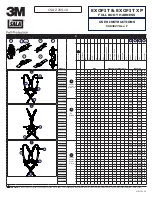
EMC INDUSTRIAL GROUP LTD
I/O Function Table
MW61A_IM_ALL_SV6.09d_en
41/47
Input Functions (edge sensitive )
16
acquire zero
0 Ϯ
17
acquire tare
1 Ϯ
18
set net
2 Ϯ
19
set gross
3 Ϯ
20
net/gross
4 Ϯ
21
5 Ϯ
22
6 Ϯ
23
7 Ϯ
24
8 Ϯ
25
9 Ϯ
26
10 Ϯ
27
11 Ϯ
28
timer start
12 Ϯ
29
13 Ϯ
30
14 Ϯ
31
15 Ϯ
C
o
n
tr
o
l2
Input Functions (edge sensitive )
32
reset total
0 Ϯ
33
totalise
1 Ϯ
34
reset peak weight
2 Ϯ
35
start2 key
3 Ϯ
36
4 Ϯ
37
user function 1
5 Ϯ
38
user function 2
6 Ϯ
39
user function 3
7 Ϯ
40
8 Ϯ
41
print total
9 Ϯ
42
print remote
10 Ϯ
43
print total remote
11 Ϯ
44
12 Ϯ
45
acknowledge alarms
13 Ϯ
46
14 Ϯ
47
capture weight
15 Ϯ
C
o
n
o
tr
o
l3
Output Functions
48
pulse output‡
0
49
motion
1
50 *
net mode
2
51
at zero
3
52
in zero band
4
53 *
manual tare entry
5
54
6
55 *
7
56
8
57
9
58
10
59
11
60
healthy
12
61
fault
13
62
alarm
14
63
alarm alert
15
S
ta
tu
s1
Output Functions
64
0
65
holding flowrate
1
66
2
67
3
68
4
69
5
70
6
71
7
72
8
73 *
user bit 3
9 Ϯ
74 *
user bit 4
10 Ϯ
75 *
user bit 5
11 Ϯ
76 *
user bit 6
12 Ϯ
77
timer output
13
78
clock active
14
79
daylight saving time
15
S
ta
tu
s2
IO FUNCTION BITS
In most cases, IO Function bits are set and reset by the controller or the digital input
signals.
MODBUS
The registers control1, control2, control3, status1, status2, status3, IOx, faults,
control4 and IOx2 can all be read over modbus.
The registers control2, control3, control1C and control1G can be written to over
modbus.
Bits marked Ϯ can also be set by writing their bit number to the IO Control register
(address 8038). Writing the negative value of the number will reset the bit. For
example writing -14 to 8038 will reset ‘user bit 1’. (write 14 to set)
MACROS
IO Function bits 1 to 187 can be set & reset using the SET_BIT, CLEAR_BIT and
TOGGLE_BIT instructions.
The IF instruction can test bits 1 to 150.
CONTROL1
The control1 register contains 16 level sensitive input signals. This register has 5
control sources which are combined together.
control1_inputs come from the digital inputs as set with the ‘INx functions’.
control1_internal are internally generated signals (e.g. the START/STOP keys).
control1C and control1G are registers accessible via communications and are for
remote control of the instrument.
control1_input_aux come from auxiliary IO
The 4 registers are or’ed together, so for example a 1 on bit 2 of any of the 4
sources will set the run bit. Any control1 register with bit 1 set (stop) will override
and cause a stop.
NOTES
To invert signal, use negative value.
e.g. for NOT run, use -2.
† IN0 is pulse input, other inputs are no function.
‡ Only OUT0 & OUT1 maybe set to pulse output. Other outputs are no function.
Ϯ can be set and reset with macros and the setting IO Control (Q25420)
* retained while power is off







































